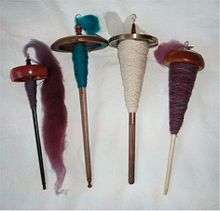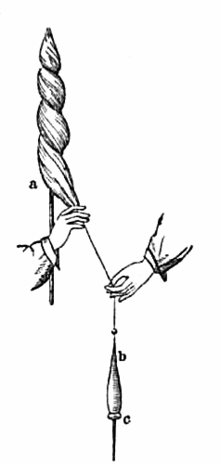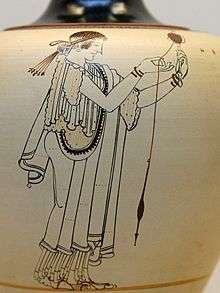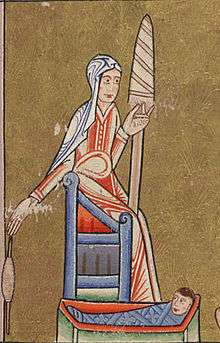Spindle (textiles)



A spindle is a straight spike usually made from wood used for spinning, twisting fibers such as wool, flax, hemp, cotton into yarn. It is often weighted at either the bottom, middle, or top, commonly by a disc or spherical object called a whorl, but many spindles exist that are not weighted by a whorl, but by thickening their shape towards the bottom, such as Orenburg and French spindles. The spindle may also have a hook, groove, or notch at the top to guide the yarn. Spindles come in many different sizes and weights depending on the thickness of the yarn one desires to spin.
History
The origin of the first wooden spindle is lost to history because the materials did not survive. Whorl-weighted spindles date back at least to Neolithic times; spindle whorls have been found in archaeological digs around the world.
A spindle is also part of traditional spinning wheels where it is horizontal, such as the Indian charkha and the great or walking wheel. In industrial yarn production, spindles are used as well; see spinning jenny, spinning mule and ring spinning.
Hand spindles
Modern hand spindles fall into two basic categories: drop spindles, and supported spindles. In both, the spindle is vertical. Drop spindles are so named because they are dropped to swing from the yarn after rotation has been started on one's thigh or any other convenient body part, allowing for a greater length of yarn to be spun before winding on. They also permit the spinner to move around while spinning, going about their day. However, there are practical limits to their size/weight.
Drop spindles are commonly available in high-whorl, low-whorl, and centre-whorl versions. In a high-whorl spindle, the whorl sits very close to the top of the shaft which allows the spindle to spin very fast. A hook is placed on the top of the shaft to secure the developing yarn, and the newly spun yarn is wound around the shaft underneath the whorl in a conical shape called a "cop". In a low-whorl spindle, the whorl sits near the bottom of the shaft, which makes it spin slower, but more steadily, and longer. The newly spun yarn is wound around the shaft just above the whorl. In centre-whorl spindles the cop is usually built above the whorl.
Most supported spindles continue to rest with the tip on one's thigh, on the ground, on a table, or in a small bowl while rotating. French spindles are "twiddled" between the fingers of one hand instead. The Akha spindle, a short spindle with a large centre-whorl disc, is supported by the hand of the spinner during drafting of cotton fibre, but during the adding of extra twist to stabilize the yarn, the spindle is dropped to rest on the yarn. Supported spindles come in a great variety of sizes, such as the very large, ~30" Navajo spindle, the small, extremely fast, metal takli for spinning cotton, and the tiniest Orenburg spindles (~20 cm, 15gm) for spinning gossamer lace yarns.
A familiar sight from history books is a spindle used in conjunction with a distaff, an upright stick with a large quantity of loose fibre wound around it, to be easily accessed. There are many other methods for controlling the pre-spun fibre, such as coiling it around one's lower arm, or through a bracelet, or wrapping it loosely around a yarn braid hanging from one's wrist.
Spindles can also be used for plying: intertwining two or more single strands of yarn together in order to create a stronger, more balanced, more durable yarn.
Cultural references
The spindle is closely associated with many goddesses, including the Germanic Holda, Norse Frigg and Freya, Egyptian Isis, Greek Artemis and Athena. It is often connected with fate, as the Greek Fates and the Norse Norns work with yarns that represent lives. Because the spinning wheel was not in common use before the 16th century in Europe, the older stories are certainly referring to hand spinning done on a spindle. Chief among these is the French fairy tale The Sleeping Beauty, where the princess is erroneously shown to prick her hand on some part of a spinning wheel in modern illustrations, rather than a spindle.
Types of spindle
Supported Spindles
Supported spindles spin on surfaces such as bowls that are usually ceramic or wooden. This type of spindle gives the user more control of the weight of the yarn. The various types of supported spindles range due to the difference in styles of spinning and yarn weight.[1] Navajo spindles have longer shafts that should reach from the ground to the top of thigh. The spun yarn is wound above the whorl.[2] In Icelandic Viking times, the people used a high whorl lap spindle to spin wool into yarn. The high whorl lap spindle has a whorl on top with a hook on the top and a long shaft like other supported spindles. Unlike the Navajo spindle, however the spun yarn is wrapped around the lower end of the spindle. First the roving is prepped by drafting it before the wool is spun into yarn. The separation between the drafting and spinning creates a softer yarn. Since it is a supported spindle, the yarn is less strained, which also makes the yarn soft.[3]
Bottom Whorl Drop Spindles
A typical bottom whorl spindle has the spun single ply yarn above the whorl instead of below it like top whorl drop spindles. Bottom whorl spindles are the preferred spindle for plying yarn. Turkish drop spindles have a low whorl spindle that have two arms that intersect to make a cross. Like other drop spindles it is spun and then it hangs while the wool is being drafted and the twist travels up the wool. When winding the spun yarn on to the arms it usually is put over and under the arms on the spindle. Even though it turns much more slowly than winding onto a regular spindle it creates a center pull ball of yarn.[4]
Top Whorl Drop Spindles
Top whorl spindles commonly have a disc on the top of the shaft with a hook at the top. Often lighter with quick revolution, they are easy to wrap yarn on so spinning is faster.[5] Rebecca Herman says, "top whorl spindles usually spin faster and quite often are lighter than their bottom whorl counterparts." Unlike other types of spindles these are used to make finer weight yarns like lace.[6]
 Ancient Greek spindle whorls, 10th century BC, Kerameikos Archaeological Museum, Athens
Ancient Greek spindle whorls, 10th century BC, Kerameikos Archaeological Museum, Athens Woman spinning. Detail from an Ancient Greek Attic white-ground oinochoe, ca. 490 BC, from Locri, Italy. British Museum, London.
Woman spinning. Detail from an Ancient Greek Attic white-ground oinochoe, ca. 490 BC, from Locri, Italy. British Museum, London. Eve spinning, the spindle in her right hand: Hunterian Psalter, ca 1170 (Glasgow University Library)
Eve spinning, the spindle in her right hand: Hunterian Psalter, ca 1170 (Glasgow University Library)
- A Tibetan woman spinning wool in Pokhara/Nepal
- ↑ http://woodlandwoodworking.bigcartel.com/types-of-spindles
- ↑ http://www.woolery.com/Store/pc/Navajo-Spindles-c279.htm
- ↑ A Handspindle Treasury
- ↑ A Handspindle Treasury
- ↑ http://joyofhandspinning.com/types-of-drop-spindles-for-spinning-wool-yarn/
- ↑ http://www.knitty.com/ISSUEspring06/FEATKSgotspin.html
See also
| Wikimedia Commons has media related to Spindles. |
